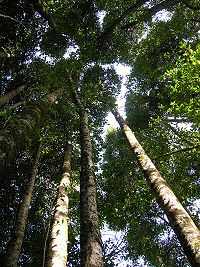Magnoliidae
The magnolids (taxon Magnoliidae) are a group of dicotyledonous plants. Its definition varies depending on the authors, it is usually located in the subclass category, which in old classification systems such as Cronquist's belonged to the Magnoliopsida class (dicotyledons), Magnoliophyta division (angiosperms).
Modern molecular phylogenetic analysis determined that among basal angiosperms (paleodicots = neither monocots nor eudicots) the most important clade is the redefined group of magnolids.
Modern phylogenetic classification
In modern classification systems such as the APG, APG II and APW this taxon is still used but with a different circumscription (that is, what subtaxa it is composed of) and it is not within the eudicots, although it is within the mesangiosperms.
In modern classification systems, this subclass consists of 4 monophyletic orders and is a sister clade to Chlorantaceae:
| Magnolide |
| ||||||||||||||||||||||||
Magnoliidae sensu Takhtajan / Cronquist
In the old Cronquist system it comprises 8 orders and 43 families.
- Order Magnoliales
- Magnoliaceae (family Magnoliaceae).
- Annoniáceas (family Annonaceae).
- Canelaceae (family Canellaceae).
- Miristicaceae (Myristicaceae family).
- Winteraceae (family Winteraceae).
- Order Nymphaeales
- Ninfeáceas (family Nymphaeaceae).
- Nelumbonaceae (family Nelumbonaceae).
- Order Laurales,
- Order Piperales,
- Aristolochial order,
- Illiciales Order,
- Random order,
- Papal Order
Magnoliidae sensu Chase & Reveal
For these authors, Magnoliidae is equivalent to Angiospermae, being considered part of Equisetopsida sensu lato and divided into about 18 superorders. The superorder Magnolianae is equivalent to the APG magnolids.
Magnoliidae sensu Dahlgren / Thorne
In the Dahlgren et al. 1985 and in the Thorne System, Magnoliidae is equivalent to the paraphyletic group Dicotyledoneae.
Comparison chart
| APG II 2003 magnoliids | Takhtajan 1958 Cronquist 1981 Magnoliidae | Dahlgren 1980 Magnolianae | Thorne System (1992) Magnolianae | Thorne Systems (2000) Magnolianae |
|---|---|---|---|---|
| Laurales | Laurales | Laurales | Magnoliales | Magnoliales |
| Magnoliales | Magnoliales | Magnoliales | ||
| Annonales | ||||
| Canellales | Winters | |||
| Piperales | Lactoridales | |||
| Aristolochiales | Aristolochiales | |||
| Piperales | Piperales in Nymphaeanae | |||
| Baseline or reassigned | Chloranthales | |||
| Illiciales | Illiciales | |||
| in Rosidae | Rafflesiales | in Rafflesianae | in Rafflesianae | |
| Nymphaeales | in Nymphaeanae | in Nymphaeanae | in Nymphaeanae | |
| Ceratophyllales | in Ranunculidae | |||
| regrouped as scholars | Nelumbons | Nelumbons | ||
| Ranunculales | in Ranunculanae | Berberidales | ||
| Papaverales | ||||
| in Dilleniidae | in Theanae | Paeoniales |
Contenido relacionado
Hydrocharitaceae
Mitochondrial crest
Zea mays





